ASUS P8Z77-V Premium Review: A Bentley Among Motherboards
by Ian Cutress on August 13, 2012 10:30 AM EST- Posted in
- Motherboards
- Asus
- Z77
USB Speed
For this benchmark, we run CrystalDiskMark to determine the ideal sequential read and write speeds for the USB port using our 240 GB OCZ Vertex3 SSD with a SATA 6 Gbps to USB 3.0 converter. Then we transfer a set size of files from the SSD to the USB drive using DiskBench, which monitors the time taken to transfer. The files transferred are a 1.52 GB set of 2867 files across 320 folders – 95% of these files are small typical website files, and the rest (90% of the size) are the videos used in the Sorenson Squeeze test.
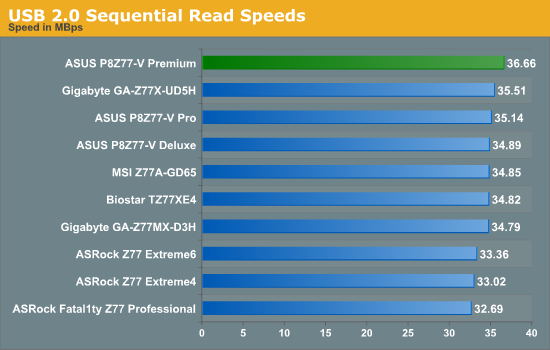
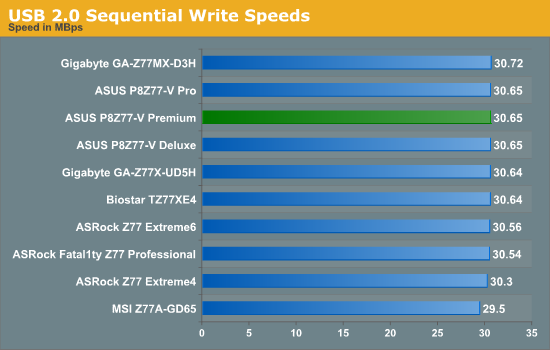
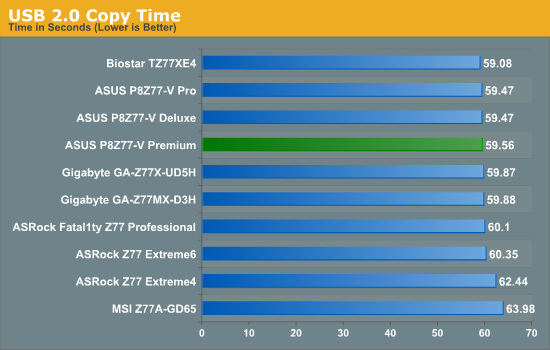
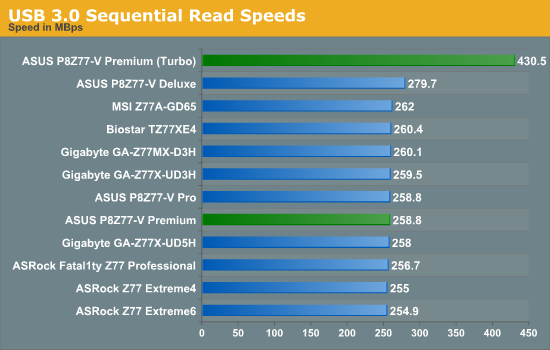
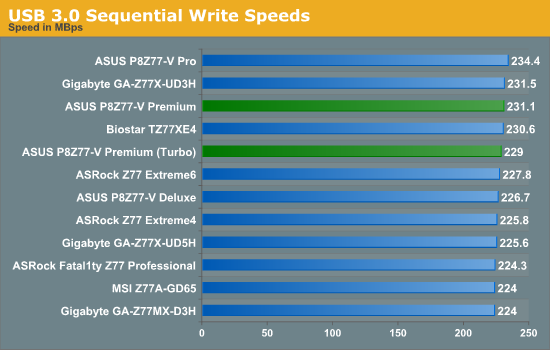
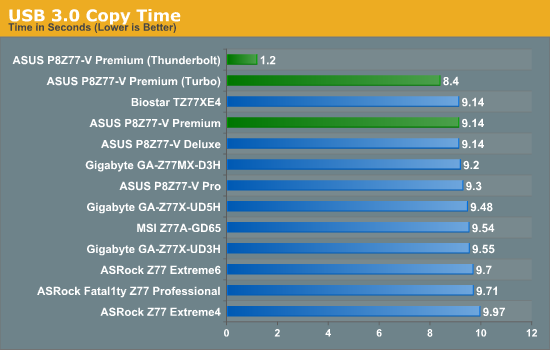
Our chipset USB testing shows the Premium in the top half of each of our graphs. Of particular note is the USB 3.0 copy test, where the Premium equals our best native USB 3.0 copy timings, and using ASUS' enhanced Turbo option on the native USB 3.0, we achieve even better performance. When attached to the ASMedia controller under UASP, the ASUS P8Z77-V Premium performs better than any other motherboard's default solution.
Also of note is our Thunderbolt result for our copy test, which comes in at 1.20 seconds. This result was erratic, sometimes going to three seconds or above. When we come to testing more Thunderbolt motherboards, we have a different copy test to probe differences between the implementations.
SATA Testing
We also use CrystalDiskMark for SATA port testing on a C300 drive. The sequential test (incompressible data) is run at the 5 x 1000 MB level. This test probes the efficiency of the data delivery system between the chipset and the drive, or in the case of additional SATA ports provided by a third party controller, the efficiency between the controller, the chipset and the drive.

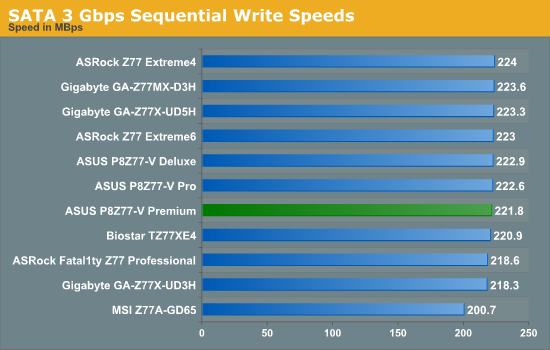
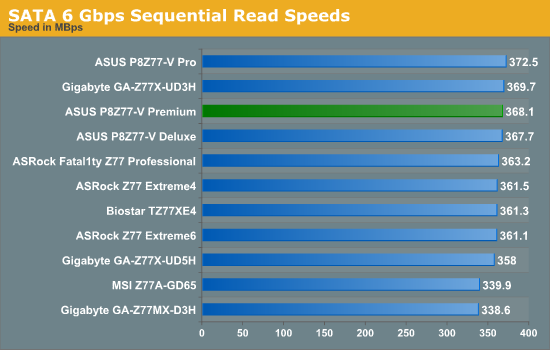
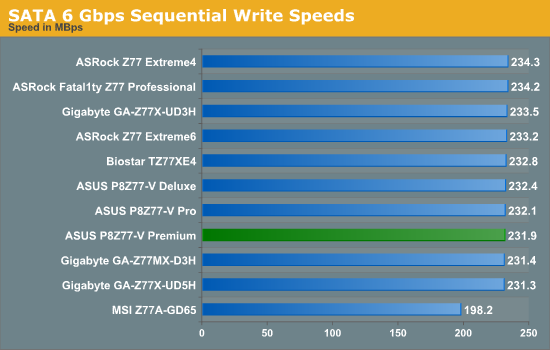
DPC Latency
Deferred Procedure Call latency is a way in which Windows handles interrupt servicing. In order to wait for a processor to acknowledge the request, the system will queue all interrupt requests by priority. Critical interrupts will be handled as soon as possible, whereas lesser priority requests, such as audio, will be further down the line. So if the audio device requires data, it will have to wait until the request is processed before the buffer is filled. If the device drivers of higher priority components in a system are poorly implemented, this can cause delays in request scheduling and process time, resulting in an empty audio buffer – this leads to characteristic audible pauses, pops and clicks. Having a bigger buffer and correctly implemented system drivers obviously helps in this regard. The DPC latency checker measures how much time is processing DPCs from driver invocation – the lower the value will result in better audio transfer at smaller buffer sizes. Results are measured in microseconds and taken as the peak latency while cycling through a series of short HD videos - under 500 microseconds usually gets the green light, but the lower the better.

Surprisingly our ASUS P8Z77-V Premium DPC test comes in at one of the highest Z77 motherboard results, double the 60 microseconds of the ASUS P8Z77-V Pro. However, the result is still under 200 microseconds, which gives it an excellent rating.










43 Comments
View All Comments
ASUSTechMKT - Tuesday, August 14, 2012 - link
It offers considerably better performance first generation 9128 and 9120 and 9130 were not bad controller just limited in peak throughput but keep in mind the controller was put to market before Intel even had SATA6G PCH. Also keep in mind performance for real world usage ( boot time, application launch performance, copy performance is pretty similar between then it is only in benchmarks you will see a measurable difference. That being noted the x2 interconnect offers twice the throughput for considerably improved performance vs the x1 interconnect 9128 type solutions. This allows newer SATA6G drives to generally perform on about the same level as the Intel PCH ( peak performance being at / near or above 500MBs on fast controllers ). Additionally it has some specific advantages not noted in the review such as stacked SSD caching. This allows up to 3 SSDs to be stacked on a mechanical drive to continue to enhance its performance.Hope this clarifies it for you.
infoilrator - Monday, August 13, 2012 - link
On any top price product certain features are necessary, useful or not, on a "has" basis.Minor omissions (in the would be nice category) would be a card reader in the front USB3.0 Device, and a PCIe expansion card with 2 firewire and 2 USB2 or USB3 plugs.
After all, too much is not enough, $450 should not require further shopping for minor add ins.
The price, if you have full use for the "package" seems acceptable, not that I'll ever have it.
TimoKyyro - Monday, August 13, 2012 - link
I would have liked to see GPU rendering benchmarks with SmallLuxGPU or Blender. This board would be perfect for animation rendering with 2 x PCIe 3.0 x16 for dual GTX 690 or 4 x PCIe 3.0 x8 for quad GTX 680.The price doesn't matter if I get faster GPU rendering and better support for new technologies like PCIe 3.0 and Thunderbolt.
IanCutress - Monday, August 13, 2012 - link
Unfortunately I do not have access to those GPUs.Ian
rahvin - Monday, August 13, 2012 - link
Are the eSATA ports port multiplier capable?mayankleoboy1 - Monday, August 13, 2012 - link
it would be great to see a PCIE3.0 SSD for tests and if it can take advantage of the extra bandwidth.DigitalFreak - Monday, August 13, 2012 - link
There is no "extra bandwidth". You're still limited to the x16 connection to the CPU.jwcalla - Monday, August 13, 2012 - link
$450???If you want to set yourself apart, how about supporting something useful like ECC RAM and 10 GbE?
Until you can do ethernet over Thunderbolt, I don't really see the point of TB on a motherboard like this.
And 10+ SATA ports... that would only be used in a file server context. But that requires ECC RAM. So it doesn't add up.
JMO.
jwcalla - Monday, August 13, 2012 - link
* Ahh yes I forgot that desktop Intel chipsets don't support ECC RAM so they can charge more for their server-based motherboards and processors.Even Cortex A-15 supports ECC. *sigh*
This space needs some serious competition. It's just the same boring features rehashed and multiplied.
Kevin G - Monday, August 13, 2012 - link
There are a few TB -> Ethernet solutions out there, including an adapter from Apple. Though with two NIC's on the board, I'm not really use-case scenario for TB on this particular motherboard. I can only fathom fast external storage and at that point the user would be better off with a solid SAS card with external connectivity.As for ECC, Intel does indeed limit their desktop processors. A handful of motherboards will support ECC if a socket 1155 Xeon is utilized. Though if ECC is critical, AMD's FX line supports ECC and up to the motherboard manufacturers to support it.